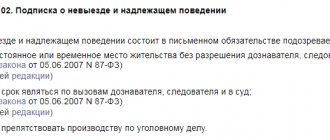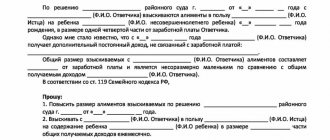Basic concept and purpose of the document
The indictment in pending cases is quite important for the process. After the execution of this document, which reflects the results of the investigative work, the preliminary investigation is completely terminated. All documents related to the case are transferred to the prosecutor's office and then sent to the court.
If there is no conclusion, subsequent trial and punishment of the offender will be impossible.
The indictment document contains all the results of the investigation. A predetermined verdict of guilty is written. This is an official certificate of transfer of the opened case for subsequent proceedings in the courts.
Having received a conclusion about the accusation, the investigator declares the official preliminary investigation completed. The evidence presented is perceived as conclusive for bringing a legitimate charge.
The process of investigating criminal acts and punishing criminals is regulated by the modern Criminal Code and procedural legislation. It is for this reason that quite strict requirements are imposed on the official conclusion, as an important document.
Rules and conditions for drawing up a document
The structure of the indictment document must fully comply with the requirements presented in Article 220 of the Code of Criminal Procedure.
The document contains the following important information:
- Personal data of the person being charged, or a list of a group of persons - full name.
- Brief information about all the people involved in the case.
- The essence of the accusation.
- Information about the criminal act - place, time, method of breaking the law, motive, purpose and accompanying circumstances.
- A legally formulated accusation with mandatory references to the law.
- A list of sources of evidence used to confirm and justify the accusation.
- List of evidence. Each factor should have a brief description.
- Identified mitigating or aggravating circumstances.
- Information about the victim with a mandatory indication of harm to health and the extent of damage caused.
- Information about the civil defendant and plaintiff.
- Signature of the investigator in charge of the case.
- Place of paperwork and date.
When drawing up a conclusion, it is imperative to adhere to the established structure. Failure to comply with this rule will result in the prosecutor rejecting the document. This will automatically delay the implementation of investigative operations and the entire investigation as a whole.
An example of a correctly executed indictment can be found on special Internet resources of Russian legal systems. From time to time you need to visit such portals to keep abreast of current changes.
Additional documents
A well-written conclusion must be accompanied by a list of additional papers and certificates. First of all, a list of citizens who are subject to subsequent summons to a court hearing is attached. Next to the personal information, the category of the participant is written - defense or prosecution and his official place of residence.
Among other additional documents that must be attached to the conclusion, the following can be noted:
- A certificate indicating the time frame for the investigation and the chosen punishment.
- List of material evidence and other facts.
- Civil action.
- Certificates proving that certain measures have been taken to comply with and implement the required penalties.
- Information about costs incurred in court.
- Documentary evidence of the protection of the rights of persons dependent on the participants in the process.
Registration procedure
The conclusion on the charges brought is drawn up by the investigator working directly on the case. It must be certified by his signature.
The document is not executed at any time, but subject to the obligatory conditions and measures taken:
- Investigation examinations and other activities were carried out.
- The available materials have been thoroughly researched and probable versions of the crime have been verified.
- The collected facts turned out to be exhaustive for the official prosecution and trial.
After checking the correctly drawn up conclusion, signing and receiving official consent from the head of the investigative committee, the investigator working on the case sends the paper to the prosecutor's office.
The prosecutor must study the paper and make an appropriate decision. This takes from 10 to 30 days. After studying the case and the papers presented, he can make one of three decisions:
- Approval of the document drawn up by the investigator and sending it to the court.
- Return of the case if procedural shortcomings were identified.
- Sending the case and related documents to a higher prosecutor. He must approve all papers.
What are the differences and similarities between an act and a resolution?
A lot of people confuse the indictment and the indictment; this is not at all strange, because the documents are similar in purpose, but there are still differences in the content of each of them.
Unlike the conclusion, the act has a dual purpose. The indictment not only represents the end of the inquiry procedure, but also gives the subject of criminal proceedings the procedural status of the accused. According to Art. 225 of the Code of Criminal Procedure of the Russian Federation, the act contains a conclusion about the need to forward the criminal case to the prosecutor for its subsequent transfer to court. The indictment contains only information about the results of the pre-trial investigation.
An indictment is made by the investigator if the investigative actions are completed and the collected amount of evidence is sufficient for a reasonable conclusion that a crime has been committed by a specific person. The document is issued if a shortened form of inquiry takes place, for example, if the criminal confessed to everything and cooperated with the investigation. The indictment lists the circumstances that take place in a particular proceeding and prove guilt, according to Art. 225 Code of Criminal Procedure of the Russian Federation.
In their content and form, the indictment and the indictment practically repeat each other. The resolution, according to Article 225 of the Code of Criminal Procedure of the Russian Federation, must be drawn up no later than 10 days from the date of the decision to conduct an inquiry in an abbreviated form.
Example and rules for drawing up an indictment in a criminal case
After signing by the investigator and the head of the investigative body, the conclusion and act are handed over to the parties to the process for review. Both parties have the right to submit the following requests:
- on recognizing the evidence specified in the indictment or act as inadmissible;
- on carrying out additional investigative and other actions to supplement the evidence base, which is not sufficient for an objective conclusion about the involvement of a particular subject in a crime;
- on the performance of additional investigative actions aimed at verifying the reliability of evidence that raises doubts;
- on restatement of the resolution if it does not meet the requirements of Part 1 of Art. 2267 Code of Criminal Procedure.
If, before the expiration of the period specified for familiarization with the resolution or act, no petition is filed, the document is sent to the prosecutor and the judge. The indictment and the act must be accompanied by a certificate indicating information about the place of residence or location of the witnesses who must testify in court.
There must be a certificate describing the preventive measure that was chosen for the suspected person, the period of inquiry in an abbreviated form and information about the presence of dependents of the arrested offender. If there are dependents, then the measures that have been taken to preserve their legal rights are described.
Together with the indictment or resolution drawn up in accordance with the instructions of Art. 225 of the Code of Criminal Procedure of the Russian Federation, all materials of the case are transferred to the prosecutor. It is important to note that the state prosecutor - prosecutor has the right, by his decision, to exclude certain points from the charge, to reclassify the criminal act, or to order the re-drafting of the resolution and act if there are inaccuracies. If the prosecutor approves the charge, the trial begins. After approval of the resolution or act by the prosecutor, petitions and statements related to the criminal case must be submitted to the judge, not the prosecutor.
Award rules
After the official paper is approved, the prosecutor sends the case to court. This is an important process of which the accused, his defense and other interested parties must be notified.
When notifying that a case has been sent to court, the prosecutor must explain what rights all participants in the proceedings have. In particular, every person has the right to request a public preliminary hearing.
The duties of the prosecutor include delivering the report and all attached documents to the accused himself. The victim of a crime and the defender of the perpetrator can also receive the paper, but only in the form of a copy.
If a citizen has already been arrested, a copy of the charges is given to him at the place of his temporary detention - a pre-trial detention center and a pre-trial detention center. The prosecutor draws up a special order and transmits it through the administration. A copy is handed over only against signature and then presented in court.
If the culprit refuses the paper, if he makes attempts to evade accepting the paper, the prosecutor has the right to redirect the case directly to the court. In such a situation, a special paper is drawn up, which states the reason why the conclusion was not handed over to the accused personally.
Basic requirements for the document
As noted above, the conclusion is drawn up and drawn up by employees of the investigative authorities. The law regulates clear rules and requirements regarding the structure and general process of document execution.
You cannot break the established rules. This will exclude the possibility of subsequent movement of the criminal case and its consideration in court.
The conclusion should be taken as seriously as possible. Only if the structure and rules of execution are observed, the document will acquire the required legal force. A well-drafted document will not allow the criminal to avoid punishment.
An important point is that the conclusion is drawn up exclusively in a single copy. The number of defendants in one case does not matter.











